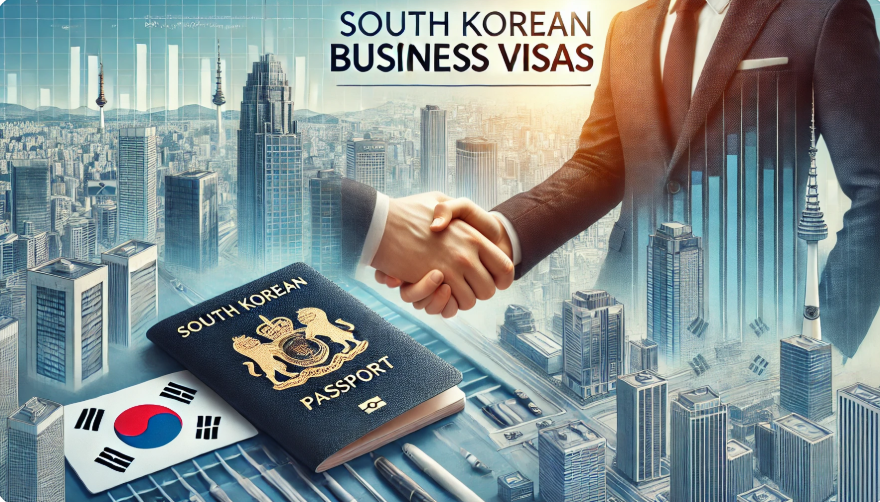How to apply for a Business Visa to South Korea?

South Korea, one of Asia’s leading economic powerhouses, attracts entrepreneurs, investors, and business professionals from around the globe. Whether you are attending meetings, signing contracts, or seeking investment opportunities, obtaining a business visa is the first step. This guide provides comprehensive details on the process of obtaining a business visa to South Korea, along with must-visit tourist destinations and the best times to explore them.
Types of South Korean Business Visas
South Korea offers different types of business visas based on the nature and duration of the visit. The most common ones include:
-
C-3-4 Short-Term Business Visa – For short-term business activities such as attending meetings, conferences, signing contracts, or conducting market research. Valid for up to 90 days.
-
D-8 Investor Visa – For individuals who plan to invest in a South Korean company or establish a business there.
-
D-9 Trade and Business Visa – For those engaged in international trade or business transactions with South Korean entities.
How to Obtain a Business Visa for South Korea?
Many business professionals frequently search for how to get a business visa to South Korea to ensure they meet all requirements for a smooth application process. Below, we outline the eligibility criteria and the required documents you need for a successful business visa application.
Eligibility and Requirements for a Business Visa
The eligibility criteria and required documents depend on the type of business visa you apply for. Generally, applicants must provide:
-
A valid passport with at least six months of validity.
-
Completed visa application form, which can be downloaded from the South Korean embassy or consulate website.
-
Passport-sized photos as per the embassy guidelines.
-
Business invitation letter from a South Korean company or organization.
-
Company registration certificate of the inviting company.
-
Proof of business activities (e.g., contracts, business agreements, event invitations, etc.).
-
Bank statements proving financial stability.
-
Round-trip flight ticket reservation and accommodation details.
-
Visa fee (varies based on visa type and duration).
Step-by-Step Application Process
-
Determine the Visa Type: Choose the appropriate business visa based on your purpose of visit.
-
Prepare the Documents: Gather all required documents to ensure a smooth application process.
-
Submit the Application: Visit the nearest South Korean embassy or consulate and submit your application. Some applicants may need to apply through a designated visa processing agency.
-
Attend an Interview (if required): Depending on your application, you may be asked to attend an interview at the embassy.
-
Visa Processing Time: It typically takes 5-10 working days for short-term business visas. However, long-term visas may take longer.
-
Receive Your Visa: Once approved, collect your passport with the business visa stamp.
-
Travel to South Korea: Ensure you carry all necessary documents, including your business invitation letter, when arriving in South Korea.
Best Tourist Places to Visit in South Korea
While in South Korea for business, take some time to explore its vibrant culture and stunning landscapes. Here are some must-visit destinations along with the best time to visit:
1. Seoul – The Dynamic Capital
Best Time to Visit: Spring (April - June) & Autumn (September - November)
Top Attractions: Gyeongbokgung Palace, N Seoul Tower, Bukchon Hanok Village, Myeongdong Shopping Street.
Why Visit? Experience a blend of modern skyscrapers and historic palaces, with vibrant nightlife and delicious street food.
2. Busan – Coastal Beauty
Best Time to Visit: Summer (June - August)
Top Attractions: Haeundae Beach, Gamcheon Culture Village, Beomeosa Temple, Jagalchi Fish Market
Why Visit? Famous for its beautiful beaches, seafood markets, and cultural landmarks, Busan is perfect for both relaxation and exploration.
3. Jeju Island – Nature’s Paradise
Best Time to Visit: Spring (March - May) & Autumn (September - November)
Top Attractions: Hallasan Mountain, Seongsan Ilchulbong, Manjanggul Cave, Jeongbang Waterfall
Why Visit? Known for its scenic landscapes, volcanic craters, and beautiful beaches, Jeju Island is a must-visit destination for nature lovers.
4. Gyeongju – The Historical Capital
Best Time to Visit: Spring (April - June) & Autumn (September - November)
Top Attractions: Bulguksa Temple, Seokguram Grotto, Anapji Pond, Cheomseongdae Observatory
Why Visit? Rich in ancient history and cultural heritage, Gyeongju is often called the ‘Museum Without Walls’ due to its numerous historical sites.
5. Nami Island – A Romantic Getaway
Best Time to Visit: Autumn (October - November) & Winter (December - February)
Top Attractions: Tree-lined paths, Winter Sonata filming locations, Zip-wire adventures
Why Visit? A picturesque island famous for its breathtaking tree-lined avenues and romantic scenery.
Final Thoughts
Obtaining a South Korean business visa is a straightforward process if you follow the proper guidelines and prepare the necessary documents. While on your business trip, take the opportunity to explore South Korea’s rich history, modern cities, and stunning landscapes. Whether it’s the bustling streets of Seoul, the coastal beauty of Busan, or the natural wonders of Jeju Island, South Korea has much to offer both business travelers and tourists alike.
- Questions and Answers
- Opinion
- Motivational and Inspiring Story
- Technology
- Live and Let live
- Focus
- Geopolitics
- Military-Arms/Equipment
- Seguridad
- Economy
- Beasts of Nations
- Machine Tools-The “Mother Industry”
- Art
- Causes
- Crafts
- Dance
- Drinks
- Film/Movie
- Fitness
- Food
- Juegos
- Gardening
- Health
- Home
- Literature
- Music
- Networking
- Other
- Party
- Religion
- Shopping
- Sports
- Theater
- Health and Wellness
- News
- Culture

